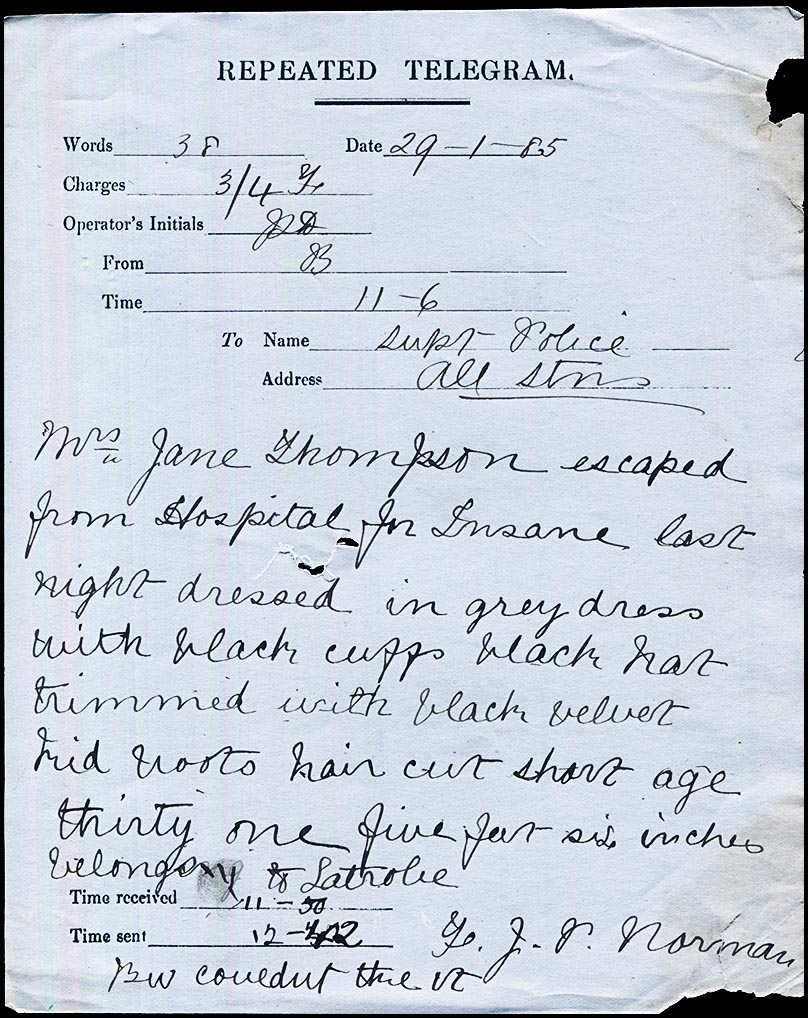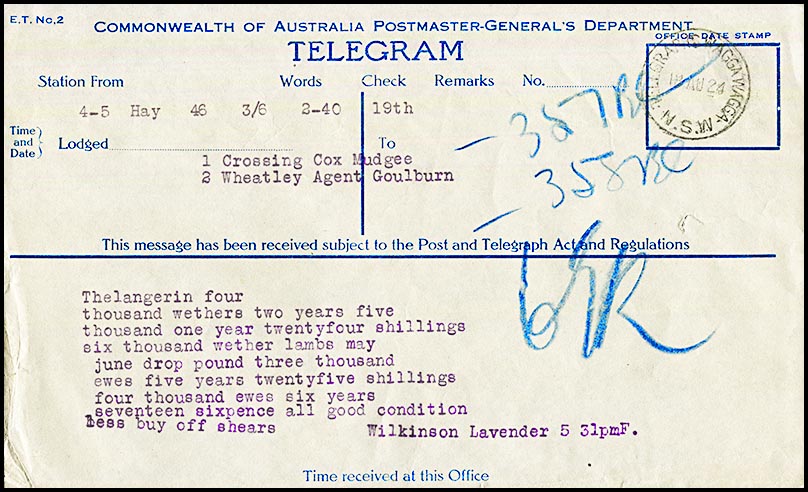Multiple telegrams.
- Australia 1901-1988
- New South Wales
- Queensland
- South Australia
- Tasmania
- Victoria
- Western Australia
- International
- Special aspects
Multiple telegrams were a type of telegraphic communication which was especially suited:
- to communicating with a number of Offices within one Government Department - for example Police Stations;
- to facilitating commercial advertising.
A single message could be sent to a large number of recipients. Alternatively a multiple telegram could be sent to several recipients to confirm sales, agreements or business strategies.
Multiple telegrams were not accepted for Europe via the Pacific cable or for places in North America via any route.
On 11 October 1902, the Fremantle Evening Courier
1. The use of multiple telegrams in Colonial days.
A very important use - almost the most important use - on multiple telegrams was to distribute the results on important cricket matches. In an appalling delay in telegraphing progress reports for an important cricket match in Melbourne, the Manager of the Sydney Telegraph Office explained he was not to blame:
"In reply to a formal complaint lodged with the manager of the telegraph station at Sydney, we received the following memo: Adverting to your note of the 28th ultimo, I am informed by the manager of the Melbourne office that the delay complained of was due to the report being addressed to other papersso a multiple telegram. , Adelaide, etc., on the same form and it appears they were sent there before Sydney".
The full context of this cricket-related story in included elsewhere.
2. Colonial example of a multiple telegram.
|
3. Post Federation example of a multiple telegram.
|
4. Regulations.
Then 1902 Commonwealth Gazette noted "Multiple telegrams may be sent to the same telegraph office, and shall be charged for as a single telegram with a further charge of half rate for each additional copy".
An article in the Hobart Mercury for 9 March 1904 argued about the methods of calculation to determine charges. It says: "As a curiosity of departmental calculation the following is interesting: The regulations prescribe that a multiple telegram shall be charged for as a single telegram with a further charge of half rate for each copy after the first with a minimum charge of 6d per copy. This sounds like a substantial concession; so it is for lengthy telegrams but if any one had to send the same telegram of say a dozen words in the message (with six on the address and one for signature) to half a dozen people in Launceston (each of them having six words in the address) it would cost him - if he availed himself of the concession of a multiple telegram - more than if, at six different times during the day, he gave the department the trouble of sending to and receiving at Launceston six separate telegrams of the same twelve words to the same six different persons".
The June 1922 Post and Telegraph Guide includes the following:
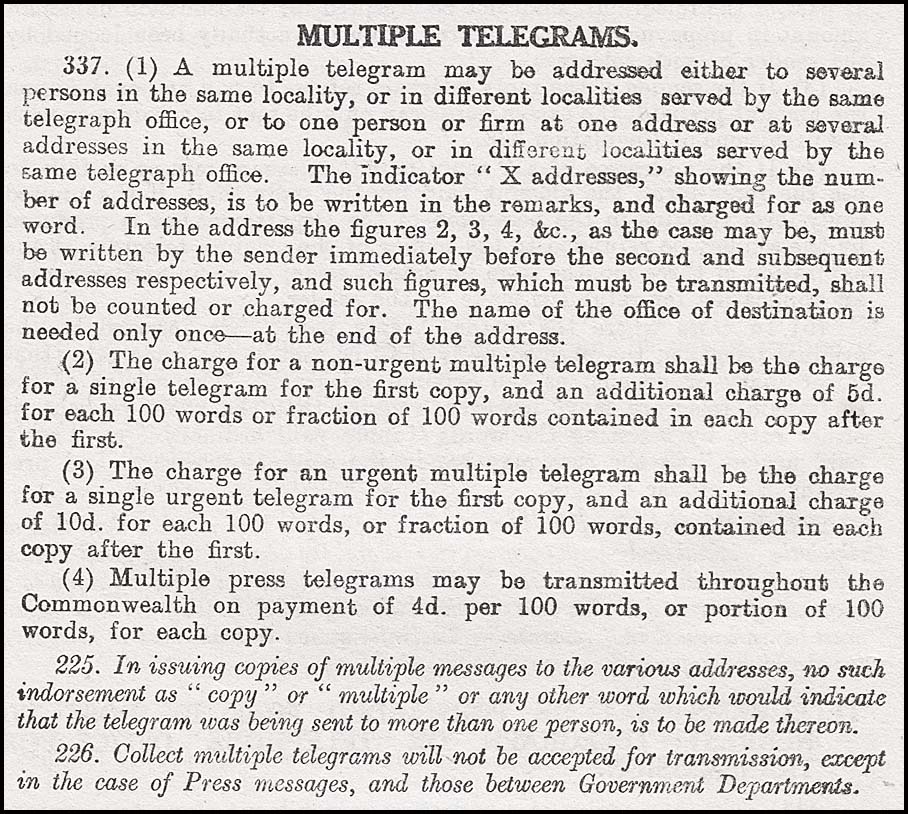 |
From 1 May 1927, the regulations for charges for multiple telegrams were amended:
"The regulation in its new form provides that the charge for a non-urgent multiple telegram shall be the charge for a single telegram for the first copy and an additional charge of 5d. for each 50 words or fraction of 50 words contained in each copy after the first.
The charge for an urgent multiple telegram shall be the charge for a single urgent telegram for the first copy and an additional charge of l0d. for each 50 words, or fraction of 50 words contained in each copy after the first".
In 1929, another announcement noted "the low rate of 5d for every 50 words or portion thereof in each copy, the original, including the whole of the addresses being charged for at ordinary rates. There is no limit to the number of telegrams which can be sent under these conditions".
Another announcement reported in the Hobart Mercury of 26 August 1929 noted:
"The Postmaster-General believes that he has found a new way of increasing the revenue. By contract with firms who will send "multiple" telegrams, he believes he can help business firms in the city who wish to advise clients in the country of "a good thing" and at the same time acquire money for the revenue. One firm of tanners in the city sent 1,800 telegrams and drew its clients' attention to a splendid line at a special price. The result was a big increase of business. This should be an interesting experiment but, of course, it is open to abuse at the hands of unscrupulous firms".
By 1931, the Department were making announcements such as the following: "Canvassing in other departments also had been successful. Fresh business in the despatch of catalogues had been obtained and the advantages of advertising by multiple telegrams and the collection of debts by telegram had been canvassed with success".
When the Commemorative Telegram form for the Opening of the Sydney Harbour Bridge was issue in 1932, a number of firms used that form to advertise their products or services.
By the end of 1932, the advertising became more focussed in its suggestions to businessmen:
"The use of the multiple telegram service - no carbon copies and each message is delivered as an original telegram for Christmas greetings, sales publicity and to move slow selling lines of goods. This service is large availed of in southern cities with most satisfactory results and its comparatively low cost. For seasonal greetings, it is cheaper than an almanac and produces a pleasant psychological effect on the recipient; it is a valuable adjunct to newspaper publicity and it will bring customers to your business. Two hundred and fifty telegrams, each of 16 words, for Cairns addressees would be approximately 7½d a message. Service on a given date could be guaranteed and the telegrams would be accepted before that date and held ready for delivery".
5. Publicity brochure.
The Post Office advertised the facility widely in magazines and through small brochures which were displayed in Post Offices or delivered together with telegrams in the various delivery envelopes. The brochure had been made to fit exactly into these envelopes.
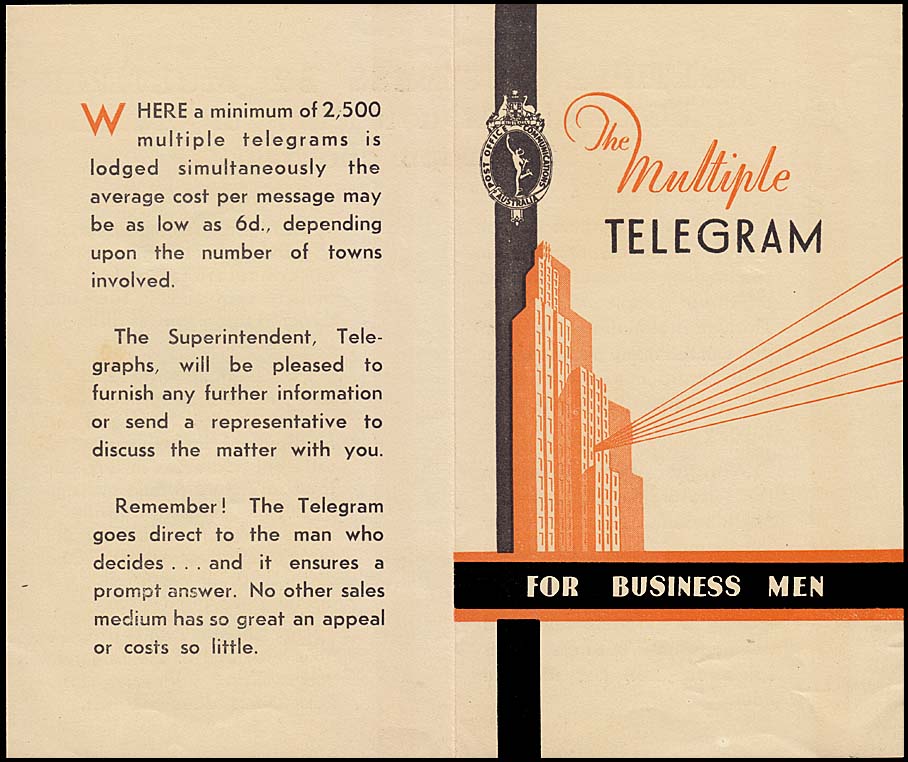 Outside of an Australian Post Office brochure advertising Multiple Telegrams. Cover is the right half of the image to the right of the fold. The back page is to the left of the fold. |
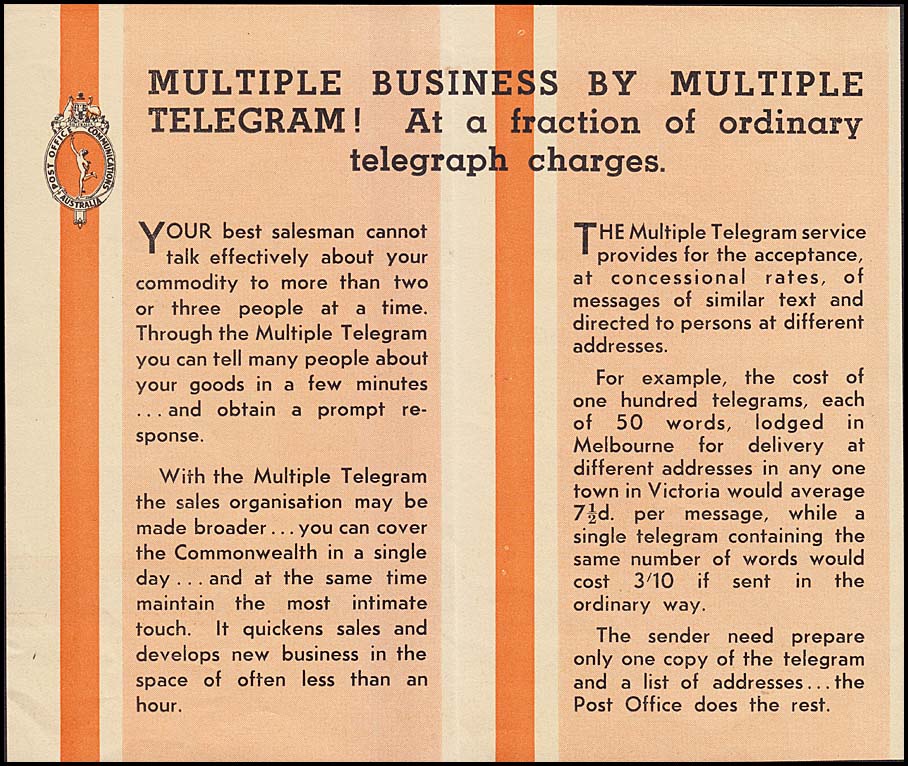 Inside of the above Australian Post Office brochure advertising Multiple Telegrams. |
6. Wires for our Debtors - G.P.Os latest idea.
The Evening News of 3 January 1931 addressed a problem of debt settlement as follows:
WIRES FOR OUR DEBTORS IS GP.O.'s LATEST IDEA.
Multiple Telegram Jolts NEXT PLEASE!
by BILL CAMERON.
The advantages of the telegraphic service in collecting long overdue accounts are set out in an attractive little publication issued by the Postmaster General's Department. Let us hope it does not get into the wrong hands, and teach citizens to bolt like scared rabbits at the sight of a telegraph messenger.
The secret, it seems, lies in the use of multiple telegrams. You just draft out a neat little message such as: 'May we remind you that your account is long overdue' and hand it in, together with the names and addresses of 150 or 15.000 citizens, and in the twinkling of a telegraph key and the flicker of messengers' boots, all those citizens are aware or rather reminded that they have owed you money for quite a while.
Of course, this will not be news to them, but there is a suggestion of urgency and of further action trembling on a hair trigger about a telegram. It creates an atmosphere of do-it-now combined with just the right flavour of delays-are-dangerous. And in the case of a big firm, as the department rightly points out, the telegram does not trickle slowly through the various channels of the organisation but goes direct to the right man and claims his personal attention.
THE LIMITATIONS.
The telegraph might be even more effective if it could wire a bulldog to a debtor and thus drive him out from behind his entrenchments and into the arms of a process server. But silence still has its unresolved problems and the electric telegraph, though an undoubted blessing to hurrying humanity, still has its limitations.
A multiple telegram of 30 words costs only about one-fifth of a penny a word and the department points out that it can be used most effectively for sales purposes and for debt collecting.
In dealing with the benefits which may be centered on creditors, the department seeks to point out how Australia's 230,000 miles of telegraph wire may be called to the assistance of that great army of citizens who are willing to become debtors or to get further into debt. This omission is probably intentional, for an appeal which is too general in scope may defeat its own object by a clouding of the issues. A guide to debtors and would-be debtors will no doubt follow in due course.
There is a certain academic interest in contemplating the advice which may be given later in this guide. Many handy suggestions occur readily enough to the thoughtful mind.
MAKE 'EM THINK
"Unless receive five pounds before noon tomorrow, must sell kiddies' dog or be punished for murdering the baliff".
Such a message as that might melt a heart of stone - provided the heart is surmounted by a head of stone, which does not realise that the dog in question is a cantakerous and sore-eyed mongrel, which nobody would accept as a gift and which the owner is thinking of destroying because it has bitten one of the children.
'Wire a pound or will suicide and you win never get what I already owe you" might produce results unless the receiver was a man who believed there was a time when cutting losses was not only permissible, but advisable, on economic grounds.
Another message which might induce a creditor to stay his hand would be: 'You are not the only creditor. Force me into bankruptcy and you will get 4d in pound. Give me free run and I may milk other cows and pay you in full".
FROM THE TOMB
Or what about this reply:
"John Smith, whom you wired to-day re account, died suddenly. Wire five quid towards funeral expenses, and I may be able to pay you half what he owed you out of estate. Mary Smith'.
You can wire money, but you can't enclose it in a telegram. Still, that will not save some hopeful creditor from receiving the following:
'Here-with please find five pound six four pence— If you can".
The map which accompanies the appeal to creditors to use the telegraphs shows lines radiating to various points of the Commonwealth but does not show King, Kangaroo, Bathurst or Melville Islands. This omission may yet be responsible for considerable growth of the insular population. As the little departmental publication sets out, very truthfully, on its title page: "It is by new ideas that the world progresses".
